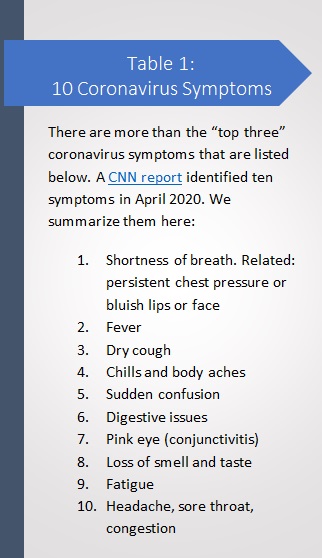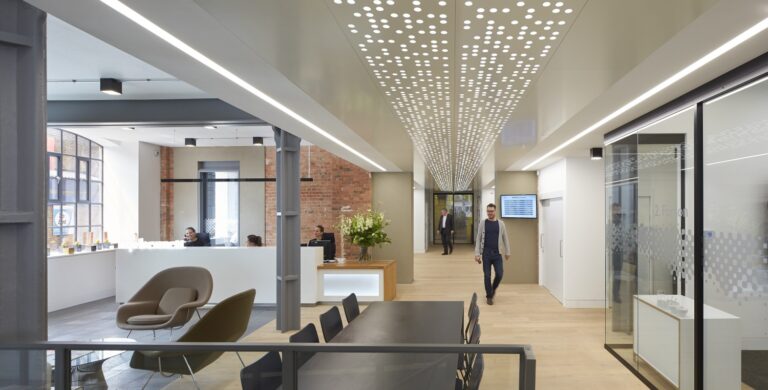This e-book was written by Peter S. Kimmel, Founding Publisher of FMLink. Its goal is to help building and facilities managers get their buildings back to the “new normal” occupancy and functioning safely for their occupants. It is written in four parts that are being published simultaneously; each links to the others. If you prefer to read a PDF, you may download the e-book here. Footnotes are at the end of each part; a full bibliography is available in the PDF.
- PART ONE: Introduction (Below)
- PART TWO: Strategies for getting the building from mostly vacant to populated
- PART THREE: Detailed considerations for key aspects of the facility and plan
- PART FOUR: Resource Guide
Kimmel was named winner of the 2020 IFMA Distinguished Author Award for Research for his work on this e-book.
PART ONE: Introduction

FMLink is proud to present this resource to its facilities management readers to help them identify what must be done in their facilities to get them occupied safely, minimizing the risk caused by the spread of the coronavirus.
Many facilities managers are struggling with the immense task in front of them–how to get our facilities back to some semblance of normal in this era of the coronavirus. A few facilities have remained totally opened, while most others are either fully closed or partially open with skeletal staffing. Before we reopen them fully, we need to believe that the occupants will be safe from the novel coronavirus, which leads to the COVID-19 disease. The facilities manager’s role, of course, is what can be done to keep the virus from spreading within our facilities. This guide is based on research from many sources—all content focuses on how to make our facilities safe for the occupants.
As countries around the world have dealt with “lockdowns” except for essential workers, they have been monitoring multiple numbers to determine whether it is safe to reopen facilities to the general public and end the lockdowns. To do that, they have studied:
- The percentage of the population that has been tested
- The percentage of the population that has contracted the COVID-19 disease
- Whether there are enough testing kits available
- Whether there is an adequate supply of personal protective equipment (PPE)
- Whether there are enough hospital beds
- How soon a vaccine may be available
It is most strange that one more item is not on the list in determining whether facilities should reopen or not:
- Will our facilities be ready so workers, customers, visitors, and suppliers can enter them safely?
When one starts to look at all that must be done to make our facilities safe, one legitimately can question whether we are ready to open them. At first glance, all that needs to be done to our facilities is a deep cleaning, make sure people space themselves out (social distancing), and figure out where those who don’t fit are going to be located. But as we examine what must happen, it gets much more complicated, and it will take time. Before our facilities will be ready to reopen, there needs to be planning, coordinating, procuring, and doing. This guide will go into detail to identify all the steps that should be taken.
First, a few words in general about this virus….
As we know, the virus can spread through droplets generated when an infected person coughs or sneezes, or through any discharge from one’s nose. It is spread most when these droplets get onto someone’s hands, which in turn may rub the mouth, nose or eyes and thus enter the body. But they also can spread by getting onto surfaces that later get touched.
Other than the preceding paragraph, this guide will not go into detail about the virus, nor will it discuss all the ways to practice good hygiene to protect ourselves and others, nor will it identify hand-washing and mask-making techniques or other valuable practices that apply to the common public. These are all over the internet for everyone to read. Rather, this guide will focus on what we, as facilities managers, need to know to keep our facilities safe and people out of harm’s way.
We also will not identify guidelines to protect special types of facilities, such as those related to healthcare and education. The discussion in this guide will work for these facilities as well, but additional guidelines will need to be applied for each type. Facilities managers from these types of facilities are encouraged to search for information on the web and through websites from specialty associations and organizations, which contain extensive information.
 It is important, however, for facilities managers and all others in a facility to identify the key symptoms of the virus. The reason is simple: we need to stop the spread of the virus at the earliest possible moment. So we need to identify the person, get him or her quarantined (separated from others), identify who else may have come in contact with that person (contact tracing), and when appropriate, get the individual tested. Each organization should have a procedure in place to make that happen. It likely will be from a health group within the organization if it has one, but at times, it could fall upon the FM’s shoulders. To that end, all in the facility, including the FM, should be aware of the most frequent symptoms, which are identified in Table 1, from CNN.[1]
It is important, however, for facilities managers and all others in a facility to identify the key symptoms of the virus. The reason is simple: we need to stop the spread of the virus at the earliest possible moment. So we need to identify the person, get him or her quarantined (separated from others), identify who else may have come in contact with that person (contact tracing), and when appropriate, get the individual tested. Each organization should have a procedure in place to make that happen. It likely will be from a health group within the organization if it has one, but at times, it could fall upon the FM’s shoulders. To that end, all in the facility, including the FM, should be aware of the most frequent symptoms, which are identified in Table 1, from CNN.[1]
This guide does not wish to replicate the already existing resources that address the reopening of the buildings. Many are quite tactical and present comprehensive checklists about one or more of the facets of reoccupying the buildings. Rather, this guide will enable you to understand the overall picture, and from that, you will be able to identify the best strategy for your company and your buildings. The best strategy for your company likely will be somewhat different from those of others; similarly, because of specific attributes of your building, the strategy for it likely will be different from that of other buildings in your company’s portfolio.
So, instead of focusing on just how to prepare each component of your facilities, we’ll help you understand the underlying principles so that you will identify what considerations must be made, and then how to go about doing them. If you will need more detailed information on “the how,” we’ll provide you with links to go directly to the specific pages in other resources.
Not all facilities managers who read this guide will be in the same place in terms of bringing their facilities back online. Furthermore, most facilities cannot just get back online by simply turning on or off a light switch. Rather, it is a process. First, the facility needs to be prepared (or prepped, if you prefer). Second, some staff will gradually start to fill it. Finally, it will be at its new capacity, which for many, is still to be determined, but will be less than it was “pre-COVID-19.” In other words, by phasing the reentry to the building and defining specific goals for each phase, one is more likely to have a successful (and safe) occupancy.
So, PART TWO of this guide is devoted to three strategies that facilities managers should implement to ensure that their facilities are safe from the virus. The first strategy identifies what needs to be done to get a facility occupied again—this is for those whose facilities have been mostly unoccupied during the pandemic. Much of what is identified can be done remotely.
The second strategy is for the facilities managers from the first phase who now are ready to start the reoccupation of their buildings. However, for other facilities that have remained partially open to accommodate essential personnel, and others that may have already started to reopen more fully—the facilities managers of these facilities will need to make sure they have gone through all the previously identified steps (Phase One) for the facilities that were closed, and then go through the additional steps identified for partially occupied facilities in Phase Two.
The guide then transitions into the third strategy—what needs to be done once the facilities get occupied up to the level of the new normal. These numbers likely are not yet defined. Pre-coronavirus, it would have meant full occupancy, but I’m not sure any of us knows for sure what that number will be—it will depend on the results of our ongoing evaluations as the buildings become occupied, coupled with new insights from global health organizations. The numbers are expected to be smaller than previous occupancy levels for two reasons:
- Social distancing guidelines, where people must keep a minimum of six feet or 1-1/2 meters from one another, will result in lower population densities in the workplace.
- Many organizations will discover that many office workers can perform equally effectively from either their homes or satellite coworking facilities.
This third strategic component also includes preparation for a second round of the coronavirus, should it occur.
PART THREE of the guide goes into more detail about many of the key elements of operations that impact the facilities manager. These include topics such as floor layouts, cleaning, HVAC, new rules for the workplace, working from home and other remote locations, and implementing safe controls to minimize workplace risk. It also summarizes all the modifications to rules and procedures that likely will be required.
The last section of this guide (PART FOUR) is devoted to resources to help you go into more depth for any of the topics presented. Many of the concepts in PARTS TWO and THREE of this guide are discussed in more detail in these resources, should you need them. We also identify comprehensive checklists and supplies you will need. More than including just a name and a link to a resources website, we locate the webpages that should be of most interest to you, and then link to those; we also provide a description of what you can expect to find there.
We recognize that each facility is different, and therefore, readers will have to carefully review each point to see whether it applies to their facilities. Use the Resources in PART FOUR if you need more information.
Many articles and webinars about the coronavirus in the workplace are in the public domain, and each of them offers something of value to the facilities professional. These come from government agencies, industry associations, outsourcing companies, design firms, furniture companies, and a few others. There also are more than 50 articles on FMLink (and still growing) related to the coronavirus—we let you know how to find them.
As time passes, more information about the virus will be known, and more resources will become available. So, it is imperative for the reader to continue the research here, which should serve as a solid foundation to what needs to be done to bring one’s facilities back online, safely and effectively.
Part 2 | Part 3 | Part 4 | Go to top ↑
[1] CNN
Sandee LaMotte, C. (2020). Coronavirus symptoms: 10 key indicators and what to do. Retrieved 9 May 2020, from https://www.cnn.com/2020/04/20/health/10-key-coronavirus-symptoms-wellness/index.html




